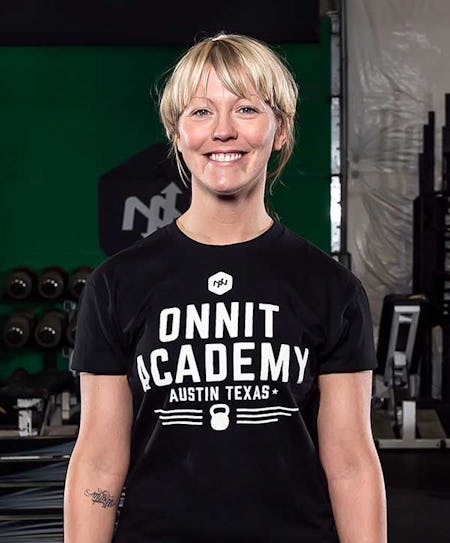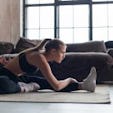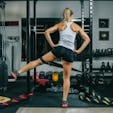Of all the unconventional training and fitness information you can find at the Onnit Academy, its Durability course may be the most unique.
Drawing from yoga, physical therapy, and various strength and conditioning methods, Onnit’s Chief Fitness Officer John Wolf calls it “the through-line to our entire fitness education system.”
Durability covers self-myofascial release (which you may call rolling on foam or a lacrosse ball), mobility, and other recovery strategies that help you move better, come back from hard workouts, rehab old injuries while preventing future ones, and continue to do the training you love long past the age when most athletes trade their running shoes for a remote control.
To help familiarize you with Durability and all its components, we want to introduce you to Onnit’s Durability Master Coach, Sarah Jamieson, a fitness entrepreneur and movement expert with more than 15 years’ experience. Read on for a two-part series in which she explains how Durability saved her body, and what it can do for yours—starting today.
Meet Sarah Jamieson

Hometown: Vancouver, BC, Canada
Certs: Onnit Durability Master Coach, Functional Movement Screen Certified Practitioner, Functional Movement Screen Level 2: Advanced Corrective Exercise
Fun fact: “My nickname is Ms. Marvel, because I’m such a huge comic book and 80s cartoon fan… I think She-Ra was my favorite. She rides a winged unicorn—that’s phenomenal. She was one of the first female superheroes.”
Onnit: What made you appreciate recovery and the Academy’s Durability curriculum?
Jamieson: I was a big runner. When I was in my early 20s, I realized that a lot of races were aligning with charities. I loved the idea that I could run and help my community, so I started to connect more of my races with organized events. I wondered if I could raise a million dollars in 10 years—I thought that would be a good goal. I connected different companies with causes that were important to me and over the course of 10 years I actually raised over two million dollars!
Then, when I was 28, my mom passed, and that’s when my world shifted. I funneled all my energy into running. I ran about 9,000km in the next year and a half—I was doing ultra marathons—and did a great deal of damage to my body. My word is my bond, so if I commit to something, I will see it through—even to the detriment of my own health.
“In our industry, the words flexibility, mobility, and stretching get tossed around all the time, interchangeably. That gives people the impression that they’re all the same thing, but they’re not.”
My body started to shut down. I got intermittent colitis. I had inflammation in my organs. My digestive system wasn’t working; nor was my endocrine system, my adrenals. I was sick all the time, tired. I had to stop running and ended up having to have major surgery—my appendix was about to rupture. This was right before my last marathon in Beirut, Lebanon, to finish up my 10-year goal. I still made I though! I ended up walking the majority of that marathon.
When I first started personal training, I learned that most people who wanted to train with me had injuries, chronic pain, and movement inefficiencies that weren’t allowing them to achieve the quality of life that they wanted. So I started moving away from strength and conditioning and the performance side of things and toward corrective exercise. I’ve done it now for the last 15 years. So, for me, the Durability concept was always there—how do I make sure the joints and the tissues work well before I load them? It just took me, personally, a while to really appreciate it for myself. It wasn’t until six years ago when my body broke down that I really applied it to myself.
How do you feel now?
Now I’m back on track! I’m seven weeks pregnant. I think people either don’t test their limits or test them too much. I learned what my limits were and what I could recover from. My priorities are also different now, as I’m about to be a mom.
Congratulations! For people who don’t know, the main component of the Academy’s Durability coursework is mobility training. To most outsiders, it looks like stretching or yoga. Can you explain it?
In our industry, the words flexibility, mobility, and stretching get tossed around all the time, interchangeably. That gives people the impression that they’re all the same thing, but they’re not. There are two things going on when we think about a person’s ability to move. There’s tissue mobility and joint mobility. Tissue mobility means the muscles have to have extensibility and elasticity. When we think about static stretching, it works when you have tissue that isn’t long enough. If you don’t have optimal length in your hamstrings, for example, then static stretching could be beneficial, but only up to a certain point. Because if you continue to stretch that tissue it’s going to stay in that position and that’s going to create compensations in other areas of the body.
Apart from lacking tissue length, people also have tight muscle tissue, which is due to tension, not a lack of tissue length. That won’t go away from stretching, but it might if you create more stability at a joint so that the muscle that attaches to it feels the body is safe when you take the joint into new ranges of motion. Then the muscles can relax the tightness and you’ll move better. That’s mobility.
Whenever you’re doing mobility training, you’re going to be stabilizing your joints and tissues at the same time. In the Durability system, we look at patterns of movement, not just body parts in isolation.
What are the mobility drills most people must work on?
I’m a big fan of ground-based movements to start off. It showcases limitations in the hips, knees, and ankles that you wouldn’t see right away if you were standing up. We like to say that “dysfunction hides in rotation,” too. So when you put the hips in a rotated position you can see what the body does to compensate for it. You can also use the floor for stability.
So, I’ll have people start with a shinbox position, which lets you work internal and external rotation of the hip at same time. Then they can add rotation to the trunk and hips—this is the core of where movement comes from. I’d do the windshield wiper and the posted knee lift. Do 3–5 reps to start. Ask yourself how your body feels. Can you maintain optimal posture?
Then I like to train the quadruped position. Get on all fours and get your pelvis neutral. You can work on the kneeling pointer, which is just going from a four-point stance to a two-point stance with one arm and leg extended. You have to fight the rotation at your core, which trains stability in your hips and shoulders. Alternate sides and do 3–5 reps each. This makes for a great warmup before running because it engages the brain to work that contralateral skill [working one arm in conjunction with the opposite leg, for example].
You can also do it before squats and deadlifts. The shinbox position really greases the groove for the hip joint and releases the low back. It opens the ankles too.
People tend to think of mobility work as just a warm-up before workouts, but you can train it anywhere—and the more often you do it, the more effective it is. What are some drills we can easily practice outside the gym?
You can do any hip tuck and tilt or lateral bend any time, anywhere. Or the hip root. You can even do them brushing your teeth.
What moves do you recommend for reversing the round-shouldered “desk posture” people get from sitting at computers all day?
When the thoracic spine can’t move, the lower back takes over. So any extension or chest-opening exercise will help your posture and reduce lower-back pain. The gunslinger is a good one to do. Round your mid back like you’re curling around a ball and reach your arms forward like you’re pointing a gun. Then extend your spine and draw the shoulder blades back to present the chest tall and proud. Desk workers should do the Academy’s open-chain standing stability series.
Mobility exercises can be very technical, and if you don’t do them properly, you don’t reap the full benefits. Can you give us some form pointers to keep in mind?
The first thing you should do is just explore the movement. Your body needs to feel what you’re asking it to do before you start trying to hone your technique. Then think about the major joint complexes. Your spine has to be tall, your pelvis has to be neutral—not tucked under. Think about keeping a proud chest but don’t flair your ribs. Your joints should be stacked on top of each other. Envision your head over your shoulders, your shoulder over your ribs, ribs over your pelvis, knees over ankles over feet. This applies to whatever position you’re in. That’s what allows for structural alignment and it goes for almost any exercise.
What else do you recommend for lower-back pain? That’s a major problem for many people.
It plagues 80% of the population. If it’s not a structural issue, movement will take you only so far. If you’re sitting all day and then lying down at night and the only time you move all day is with me, the pain is only ever going to come down a bit. You have to change your lifestyle. Move more.
But if you have back pain, you probably don’t have optimal range in your thoracic spine. Use tennis balls on each side of your spine and roll down the spine into the sacrum, hips, and glutes. Release the tension around your spinal cord and then go into the shoulders, mid back, and hips. As far as mobility exercises, I’d work on the T-spine bow and arrow draw or elbow-to-knee reach and roll.
How about shoulder pain?
Figure out how much range you have in your AC joint and scapulae. I like doing a floor press, which is very similar to a gymnast’s sit. It teaches you how to engage your shoulder blades. Put blocks on the floor on each side of your hips. Place your hands on the blocks and push your body off the ground—come up about an inch. Hold 3–5 seconds and then lower your hips back down by pulling your shoulder blades together and keeping your elbows locked. Hold another 3–5 seconds and press again.
Can you move your shoulders up and down and hold your body up with elbows locked? This trains your scaps to stabilize your shoulders, not your AC joint, which takes pressure off it. This is great for doing any kind of pressing more safely.
Another one: Inverted scap pulls on a suspension trainer. Set the rings so they hang at a 45-degree angle. Hold them with your arms straight out and lean back so your body is suspended. Retract your shoulder blades and hold five seconds and then let them spread and hold it five seconds.
The most popular recovery tool among mainstream gym goers has to be the foam roller. How do you use it?
I like to use it for the fascia and muscular system. It’s releasing muscles but most don’t know that it’s also rolling the fascia [the connective tissue that covers and links the muscles together], nerves, and blood vessels. It’s not so much for releasing tight tissue but increasing the viscosity, or water, in the tissue.
If you squeeze a sponge out and then put it under water, it will suck water into it. That’s what rolling is doing, and that gives you a temporary release of the stickiness in the muscles that reduces mobility. Increasing hydration in your tissues is very beneficial and stimulates the nervous system.
Do you like rolling before or after the workout?
Studies show that it’s better post workout. If you do it before, it may negatively affect your performance because you’re asking your nervous system to do two different things. When you lift weights, you want your nervous system to be active so you can generate power. Rolling relaxes you and releases the compression that comes with training. It helps remove toxins from your tissues.
You can roll before training, but do it short and sweet and limit it to one area. If my client has a tight lower back and wants to release it before we train, no problem. But I’ll talk to them to keep them engaged. I don’t want them to be super chill when we have work to do.
If you’ve been sitting for the last five hours, you could do a psoas [hip flexor] release on a ball before you lift. But just be aware that pre-workout rolling can send people into the nap zone really quickly.
Follow Sarah on Instagram at @moveolution and moveolution.com
Check out her supplement recommendations at her pro page.

)






